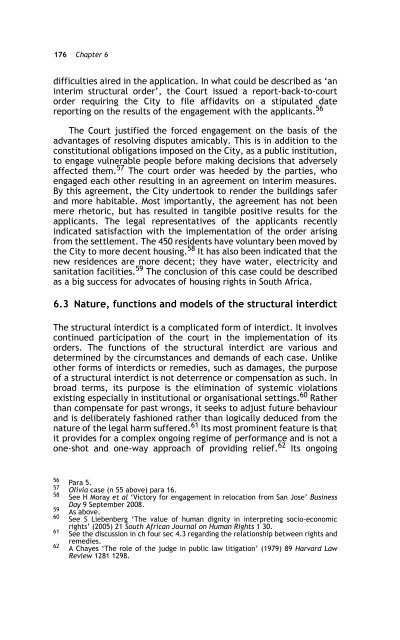LITIGATING SOCIO-ECONOMIC RIGHTS IN SOUTH AFRICA - PULP
LITIGATING SOCIO-ECONOMIC RIGHTS IN SOUTH AFRICA - PULP
LITIGATING SOCIO-ECONOMIC RIGHTS IN SOUTH AFRICA - PULP
Create successful ePaper yourself
Turn your PDF publications into a flip-book with our unique Google optimized e-Paper software.
176 Chapter 6<br />
difficulties aired in the application. In what could be described as ‘an<br />
interim structural order’, the Court issued a report-back-to-court<br />
order requiring the City to file affidavits on a stipulated date<br />
reporting on the results of the engagement with the applicants. 56<br />
The Court justified the forced engagement on the basis of the<br />
advantages of resolving disputes amicably. This is in addition to the<br />
constitutional obligations imposed on the City, as a public institution,<br />
to engage vulnerable people before making decisions that adversely<br />
affected them. 57 The court order was heeded by the parties, who<br />
engaged each other resulting in an agreement on interim measures.<br />
By this agreement, the City undertook to render the buildings safer<br />
and more habitable. Most importantly, the agreement has not been<br />
mere rhetoric, but has resulted in tangible positive results for the<br />
applicants. The legal representatives of the applicants recently<br />
indicated satisfaction with the implementation of the order arising<br />
from the settlement. The 450 residents have voluntary been moved by<br />
the City to more decent housing. 58 It has also been indicated that the<br />
new residences are more decent; they have water, electricity and<br />
sanitation facilities. 59 The conclusion of this case could be described<br />
as a big success for advocates of housing rights in South Africa.<br />
6.3 Nature, functions and models of the structural interdict<br />
The structural interdict is a complicated form of interdict. It involves<br />
continued participation of the court in the implementation of its<br />
orders. The functions of the structural interdict are various and<br />
determined by the circumstances and demands of each case. Unlike<br />
other forms of interdicts or remedies, such as damages, the purpose<br />
of a structural interdict is not deterrence or compensation as such. In<br />
broad terms, its purpose is the elimination of systemic violations<br />
existing especially in institutional or organisational settings. 60 Rather<br />
than compensate for past wrongs, it seeks to adjust future behaviour<br />
and is deliberately fashioned rather than logically deduced from the<br />
nature of the legal harm suffered. 61 Its most prominent feature is that<br />
it provides for a complex ongoing regime of performance and is not a<br />
one-shot and one-way approach of providing relief. 62 Its ongoing<br />
56<br />
Para 5.<br />
57 Olivia case (n 55 above) para 16.<br />
58 See H Moray et al ‘Victory for engagement in relocation from San Jose’ Business<br />
Day 9 September 2008.<br />
59 As above.<br />
60 See S Liebenberg ‘The value of human dignity in interpreting socio-economic<br />
rights’ (2005) 21 South African Journal on Human Rights 1 30.<br />
61 See the discussion in ch four sec 4.3 regarding the relationship between rights and<br />
remedies.<br />
62<br />
A Chayes ‘The role of the judge in public law litigation’ (1979) 89 Harvard Law<br />
Review 1281 1298.
















